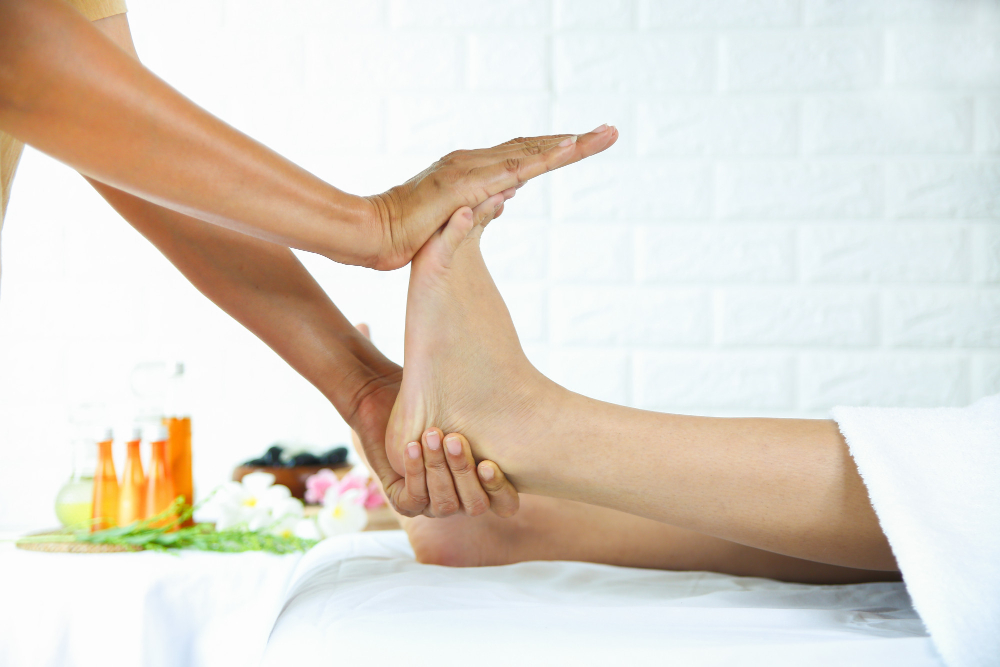If you’ve ever felt your feet bear the world’s weight, you’re not alone. Our feet endure daily stress, yet they remain one of the most overlooked areas of our bodies. Experience Thai Foot Massage, a healing tradition that blends relaxation, pressure point therapy, and wisdom to refresh your body.
Whether you’re just curious or looking to start a wellness spa business, this guide will teach you everything you need to know about Thai Foot Massage, including its origins, techniques, and the incredible ways it can boost your overall health.
What is Thai Foot Massage?
Thai Foot Massage is a treatment that blends reflexology, acupressure, and traditional Thai medicine elements. This technique applies pressure to certain points on the feet that correspond to organs and systems in the body. The concept is straightforward yet impactful: stimulating the correct points on the feet can aid in healing or energizing connected areas throughout the body.
This approach offers more than superficial indulgence. A healthy Thai massage session engages not just your feet but provides a comprehensive wellness experience in 30 to 60 minutes.
Benefits of Thai Foot Massage
A key reason for this technique’s rising global popularity is its wide-ranging benefits for physical, emotional, and mental well-being.
1. Relieves Stress and Promotes Deep Relaxation
Thai massage’s most immediate and noticeable benefits stem from its ability to calm your nervous system. It is designed to relieve mental tension through rhythmic motions and gentle pressure. One session can make you feel more grounded, relaxed, and refreshed.
2. Boosts Blood Circulation
Improved blood circulation is another key benefit. The massage techniques encourage greater blood flow to the lower legs and feet, which means your cells receive more oxygen and eliminate toxins more efficiently.
3. Reduces Pain and Muscle Tension
Regular sessions can help reduce chronic pain, especially in the legs, lower back, and hips. The pressure points targeted during a Thai Foot Massage can relax tight muscles, reduce inflammation, and ease joint stiffness.
4. Improves Sleep Quality
If you have difficulty sleeping, this massage could become your preferred bedtime routine. By lowering cortisol levels (the stress hormone) and boosting serotonin production, a beneficial Thai massage can help prepare your body for a good night’s sleep.
5. Supports Digestive Health
Believe it or not, pressing the right points on your feet can support your stomach and intestines. Many of the benefits of Thai massage include a well-functioning digestive system, fewer issues with bloating, and better nutrient absorption.
6. Stimulates the Lymphatic System
Your lymphatic system plays a huge role in your immune health. A Thai Foot Massage can encourage lymphatic drainage, which helps your body detox naturally, reduces swelling, and boosts immunity.
7. Enhances Mental Clarity and Focus
This might sound surprising, but mental clarity is one of the underrated benefits of Thai massage. Improving circulation and calming the nervous system sharpens focus and enhances presence.
8. Promotes Natural Healing
Holistic healing views the body as a connected system. Thai massage promotes self-healing by applying targeted pressure to certain foot areas and avoiding medications and invasive techniques.
Techniques Used in Thai Foot Massage
You don’t have to be a professional to recognize or attempt a simple version of this technique. Here are the main components that define a traditional Thai Foot Massage session.
1. Reflex Point Stimulation
The therapist uses thumbs, knuckles, or wooden sticks to consistently apply pressure to reflex points in the foot. Each point is linked to a specific organ or bodily system. It’s akin to providing a comprehensive tune-up for your entire body via your feet.
2. Stretching Movements
Stretching is integrated into the routine to increase flexibility and relieve muscle tension. The therapist might gently rotate your ankles or flex your toes to release built-up tension.
3. Kneading and Rolling
Like kneading dough, this technique efficiently relaxes the tight fascia (connective tissue) encasing the muscles. It also provides a delightful release after a long day of being on your feet.
4. Use of Massage Oils or Balms
Therapists often use essential oils or herbal balms to enhance the experience. These don’t just smell great; they also help with muscle relaxation and improve skin texture.
5. Wooden Reflexology Sticks
In a traditional healthy Thai massage, wooden sticks are often used for deeper stimulation. These tools target points that are harder to reach with fingers alone.
Tips for Getting the Most Out of Your Thai Foot Massage
To truly enjoy the experience and absorb all the benefits of Thai massage, here are a few tips:
- Stay Hydrated: Drink plenty of water before and after your session.
- Wear Comfortable Clothing: Loose-fitting clothes allow your therapist to work more easily around your feet and lower legs.
- Communicate: If a particular point feels too intense or uncomfortable, inform your therapist.
- Be Consistent: Like any wellness practice, the benefits compound over time. Regular sessions can do wonders for your body and mind.
Final Thoughts
You don’t need to fly to Thailand to experience the magic of a Thai Foot Massage. Whether booking a session at a local spa or considering it as an offering in your future wellness venture, this practice is worth exploring.
Its capacity to rejuvenate energy, alleviate stress, and enhance physical wellness is evident. If you aim to launch a wellness spa business, incorporating healthy Thai massage into your offerings is a choice you and your clients will not regret.







